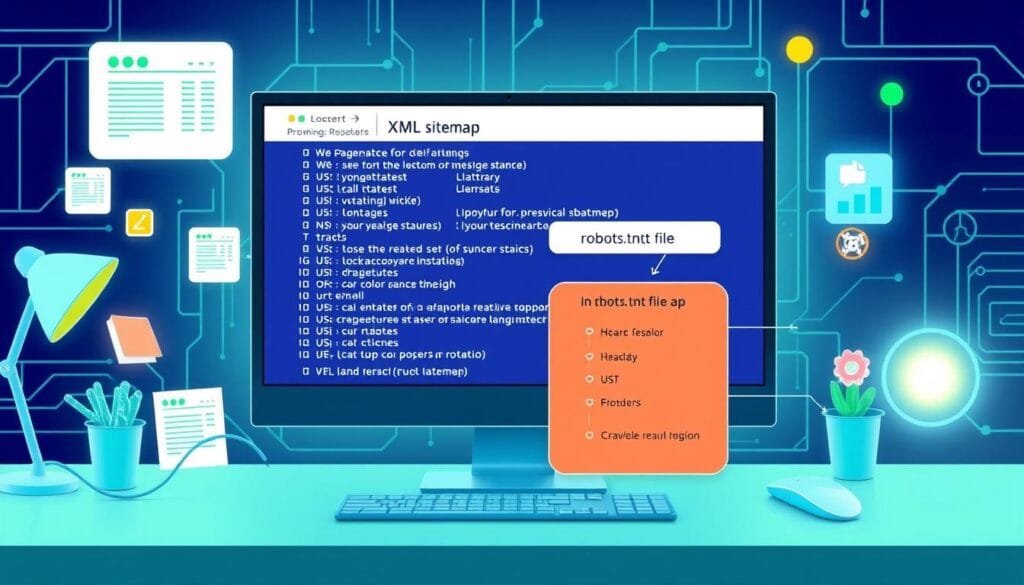Technical SEO: The Backbone of Digital Marketing Success
Technical SEO is key to a winning digital marketing plan. It makes a website more visible and credible online. A good strategy must include technical SEO to outdo rivals.

Adding technical SEO to your plan boosts your website’s online presence. It’s vital for search engines to see your site clearly. This means more people can find you online.
Introduction to Technical SEO
A digital marketing strategy needs technical SEO to shine. It unlocks a website’s full potential, making it more visible and user-friendly. Keeping up with technical SEO trends is crucial for lasting success.
Key Takeaways
- Technical SEO is the foundation of a successful digital marketing strategy
- It improves a website’s visibility, credibility, and overall performance in search engine results
- A well-planned digital marketing strategy should include technical SEO
- Technical SEO is essential for search engine optimization
- It helps search engines understand the structure and content of a website
- Staying up-to-date with the latest technical SEO best practices is crucial for long-term success
Understanding What Technical SEO is in Digital Marketing
Technical SEO is key in digital marketing. It helps websites rank better in search engines. It includes website structure, page speed, and mobile-first indexing. Knowing these helps businesses boost their online presence and get more visitors.
For any business, technical SEO basics are vital. This means making your website easy to navigate, fast to load, and mobile-friendly. A well-optimized site ranks higher in search results, bringing more visitors.
Technical SEO is crucial for a digital marketing strategy. It helps websites be seen more and get more organic traffic. By focusing on technical SEO, businesses can stand out and grow over time. Key areas include:
- Website architecture and navigation
- Page speed optimization and mobile-first indexing
- Technical SEO basics, such as meta tags and header tags
Core Components of Technical SEO
Technical SEO has many parts that work together. They help improve website optimization and search rankings. By understanding and using these, businesses can create a strong technical SEO plan.
The Role of Technical SEO in Digital Strategy
Technical SEO is vital for any digital marketing plan. It lays the groundwork for online success. By focusing on technical SEO, businesses can boost their online visibility, attract more visitors, and increase sales.
Why Technical SEO Matters for Business Growth
Technical SEO is crucial for business growth. It gives businesses an edge and leads to long-term success. By investing in technical SEO, businesses can make their websites better, rank higher in search engines, and get more visitors.
The Evolution of Technical SEO Practices
Technical SEO trends have changed a lot over the years. This is because of updates to search engine algorithms. These updates help users find more relevant and useful results. It’s key for websites to keep up and stay optimized. Staying up-to-date with the latest technical SEO trends is crucial for maintaining a competitive edge.
Search engine algorithms are very important for website optimization. By understanding how these algorithms work, website owners can make better technical SEO strategies. This includes optimizing website structure, improving page speed, and ensuring mobile-friendliness.
Some key areas of focus for website optimization include:
- Mobile-first indexing
- Page speed optimization
- Technical SEO audits
By focusing on these areas, website owners can boost their website’s visibility. This can drive more traffic and increase conversions. As search engine algorithms keep evolving, it’s vital to stay informed about the latest technical SEO trends and best practices for long-term success.
| Technical SEO Trend | Importance |
|---|---|
| Mobile-first indexing | High |
| Page speed optimization | High |
| Technical SEO audits | Moderate |
Essential Technical SEO Elements for Website Architecture
A well-structured website is key for technical SEO success. It involves optimizing site structure, URL structure, and internal linking. A clear site structure helps search engines understand your content and hierarchy.
Site structure is crucial in website architecture. It should be easy for users to navigate and find what they need. This can be done by having a simple navigation menu, clear headings, and making sure all pages are accessible quickly.
Key Elements of Website Architecture
- Clear and organized site structure
- Optimized URL structure
- Internal linking strategies
- Mobile-friendly design
URL optimization is also key for website architecture. It means creating URLs that are descriptive and concise. This helps search engines understand your website’s hierarchy and crawl it more efficiently.
Internal linking strategies are also vital. They help users and search engines navigate your website. By using descriptive anchor text and linking to relevant pages, you can enhance user experience and increase your website’s visibility in search results.
| Technical SEO Element | Importance |
|---|---|
| Site Structure | High |
| URL Optimization | Medium |
| Internal Linking Strategies | High |
Mobile-First Indexing and Responsive Design
Most people now use mobile devices to access websites. Mobile-first indexing is key in technical SEO. It’s vital to have a responsive design for mobile devices to offer a smooth user experience and better search rankings.
By focusing on mobile-first indexing and responsive design, businesses can boost their online presence. A website that adapts well to different screens and devices ensures a great user experience. This leads to more engagement, lower bounce rates, and better search rankings.
Important points for website optimization include:
- Ensuring fast page load times on mobile devices
- Optimizing images and content for mobile devices
- Using a responsive design that adapts to different screen sizes and devices
By prioritizing mobile-first indexing and responsive design, businesses can lead the way. They provide a better user experience, which improves search rankings and online visibility.
Speed Optimization Techniques for Better Rankings
Speeding up a website is key for better search rankings and user experience. This means page speed optimization, which boosts a site’s performance. Faster load times attract more visitors and boost sales.
Server response time is a big part of this. It’s how fast a server answers a user’s request. Faster servers mean faster sites. Another key method is resource compression, which makes files smaller for quicker loading.
Page Load Time Optimization
Improving page load times is vital for a good user experience and search rankings. This can be done by optimizing images, reducing code, and using browser caching.
Server Response Time Enhancement
To make servers respond faster, you can tweak server settings, use CDNs, and apply caching.
Resource Compression Methods
Compressing resources makes files smaller for quicker loading. This can be done with Gzip, Brotli, and image compression.
Using these speed optimization techniques can make a website run better. This leads to more visitors and higher sales. Whether it’s making pages load faster, servers respond quicker, or files are smaller, speeding up your site is crucial for success online.
| Optimization Technique | Description |
|---|---|
| Page Load Time Optimization | Optimizing images, minifying code, and leveraging browser caching |
| Server Response Time Enhancement | Optimizing server configuration, using CDNs, and leveraging caching techniques |
| Resource Compression Methods | Using Gzip compression, Brotli compression, and image compression |
XML Sitemaps and Robots.txt Configuration
Two key elements often missed in website optimization are XML sitemaps and robots.txt. They help search engines understand your site’s layout and content. This ensures your site is crawled and indexed well.
Creating and submitting XML sitemaps is vital for better visibility. They help search engines find and crawl your site’s pages. This reduces the chance of pages being missed or left out.

Configuring robots.txt files is also important for website optimization. This file stops search engines from crawling sensitive or unnecessary pages. It helps avoid crawl errors and boosts website security.
- Improve website crawlability with XML sitemaps
- Enhance website security with robots.txt configuration
- Increase website visibility through proper website optimization
By using XML sitemaps and robots.txt in your website optimization plan, you can make your site better. It will also show up more in search engine results.
| XML Sitemaps | Robots.txt | Website Optimization |
|---|---|---|
| Improves crawlability | Enhances security | Increases visibility |
| Reduces missed pages | Reduces crawl errors | Improves search engine rankings |
Security and SSL Implementation
Keeping your website safe is key to protecting user data and stopping hackers. Using SSL certificates and switching to HTTPS is vital for your site’s security. It also helps your site rank better in search engines. By following security best practices and setting up HTTPS, you can keep your online space safe and earn user trust.
Getting an SSL implementation is a big step in website security. It means you get an SSL certificate for your site. This certificate encrypts data between your site and users, making it hard for hackers to get to.
HTTPS Migration Process
The HTTPS migration process has a few steps. First, you get an SSL certificate. Then, you set up your site to use HTTPS. Lastly, you update all links to the new protocol. Make sure to test your site well after migration to check everything works right.
Security Headers and Best Practices
Setting up security headers is also crucial for your site’s safety. This includes things like Content-Security-Policy and X-Frame-Options. By following the best practices for security headers and SSL implementation, you can protect your site and keep users trusting you.
Here are some tips for security headers and SSL implementation:
- Choose a trusted SSL certificate provider.
- Set up security headers to fight off web attacks.
- Keep checking and updating your SSL setup regularly.
- Make sure all your site’s links use HTTPS.
Schema Markup and Structured Data
Schema markup and structured data help search engines understand websites better. They provide rich snippets and enhance search results. By using schema markup, businesses can boost their search rankings, attract more visitors, and get more conversions.
There are different types of schema markup, like microdata, JSON-LD, and RDFa. Each has its own rules and best practices. For instance, microdata uses HTML attributes, while JSON-LD uses a JavaScript object.
Types of Schema Markup
- Microdata
- JSON-LD
- RDFa
Implementation Guidelines
To use schema markup well, follow best practices. Use a consistent format, test and validate the markup, and watch its performance. Google’s Structured Data Markup Helper is a great tool for this.
Testing and Validation Methods
Testing and validation are key to correct schema markup use. Use tools like Google’s Rich Results Test or the Structured Data Markup Helper. This ensures your website offers a great user experience and boosts search rankings.
| Schema Markup Type | Implementation Guidelines | Testing and Validation Methods |
|---|---|---|
| Microdata | Use HTML attributes to embed metadata | Use Google’s Structured Data Markup Helper |
| JSON-LD | Use a JavaScript object to define the schema | Use Google’s Rich Results Test |
| RDFa | Use HTML attributes to embed metadata | Use the Structured Data Markup Helper |
JavaScript SEO and Dynamic Rendering
Search engines are getting better at crawling and indexing JavaScript content. Businesses need to make sure their sites are ready for dynamic rendering. This is where JavaScript SEO helps, making sites perform better, attract more visitors, and boost sales.
Important things to think about for JavaScript SEO and dynamic rendering include:
- Make sure JavaScript files are small and fast to load
- Use a content delivery network (CDN) to speed up JavaScript files
- Try dynamic rendering methods like server-side or client-side rendering to enhance site performance
By grasping JavaScript SEO and using the best dynamic rendering methods, companies can make their sites run smoother.

For website optimization, focus on a great user experience. This means fast loading times and simple navigation. Achieve this with technical SEO tactics, including JavaScript SEO and dynamic rendering.
Technical SEO Audit Processes
A technical SEO audit is key to finding and fixing website problems. Regular audits help improve website performance, attract more visitors, and boost sales. It involves checking a website’s structure, content, and how well it works using important tools.
Choosing the right tools is crucial for a good technical SEO audit. Tools like Google Search Console, Ahrefs, and SEMrush are essential. They spot issues like broken links, duplicate content, and slow loading pages.
Essential Audit Tools
- Google Search Console
- Ahrefs
- SEMrush
Common Issues and Solutions
During a technical SEO audit, common problems like broken links, duplicate content, and slow loading are often found. To fix these, you can repair broken links, create original content, and optimize images and videos for faster loading.
Regular Maintenance Checklist
Keeping a website optimized requires a regular maintenance plan. This plan should include checking website performance, updating content, and fixing broken links. By doing this, your website will stay efficient and attract more visitors.
Regular technical SEO audits and the right tools are vital for a better website. Don’t forget to make a maintenance checklist to keep your site running smoothly over time.
| Audit Tool | Function |
|---|---|
| Google Search Console | Monitors website performance and identifies issues |
| Ahrefs | Analyzes backlinks and identifies opportunities for improvement |
| SEMrush | Provides technical SEO audits and recommends solutions |
International SEO and Multilingual Considerations
For businesses worldwide, international SEO is key for success. It’s about knowing how to do SEO for different languages and regions. This helps businesses get more online visitors and make more sales in various markets.
Understanding website optimization for different languages and areas is important. This means making content, metadata, and URLs fit for each audience. Here are some tips for international SEO and multilingual sites:
- Using hreflang tags to specify language and region
- Creating content that is relevant and engaging for local audiences
- Optimizing website architecture for easy navigation and accessibility
A good international SEO plan can help businesses thrive globally. By focusing on multilingual SEO and website optimization, companies can boost growth, revenue, and online presence.
| International SEO Strategies | Benefits |
|---|---|
| Optimizing content for local audiences | Increased relevance and engagement |
| Using hreflang tags | Improved website architecture and accessibility |
| Creating multilingual websites | Broader audience reach and increased conversions |
Conclusion: Implementing Technical SEO for Long-term Success
Technical SEO is key for lasting success in digital marketing. It focuses on making your website better and keeping up with new SEO trends. This helps your site get more visitors, increase sales, and boost your online presence.
Improving your site’s structure, speed, and security is vital. Each step helps users have a better experience and improves your site’s ranking on search engines. This is how you make your website more visible and attractive to visitors.
Starting with technical SEO might seem hard, but the rewards are worth it. Working with SEO experts or learning it yourself can set your business up for long-term success. Keeping up with SEO changes makes your site fast, secure, and ready for search engines and users.
FAQ
What is Technical SEO?
Technical SEO makes a website better for search engines. It improves how a site looks and works. This includes making the site fast, mobile-friendly, and easy for search engines to find and rank.
Why is Technical SEO Important for Digital Marketing Success?
Technical SEO is key for digital marketing. It boosts a website’s visibility and drives more visitors. This helps businesses grow and stay ahead in the digital world.
What are the Core Components of Technical SEO?
Technical SEO focuses on several key areas. These include website structure, speed, mobile-friendliness, and more. It also covers security, schema markup, and JavaScript optimization.
How does Technical SEO Evolve Over Time?
Technical SEO changes as search engines update their rules. Keeping up with these changes is vital. This ensures your website stays competitive and optimized.
What are the Essential Elements for Website Architecture Optimization?
Good website architecture is crucial. It includes a clear site structure, optimized URLs, and smart internal links. This helps search engines and users navigate your site better.
Why is Mobile-First Indexing Important for Technical SEO?
Most people use mobile devices to access websites. Mobile-first indexing is key for this. A mobile-friendly site improves user experience and search rankings.
What are the Key Speed Optimization Techniques for Better Rankings?
Speed is vital for rankings. Techniques like page load time optimization and server response time improvement are essential. These make your site faster and more user-friendly.
How do XML Sitemaps and Robots.txt Configuration Benefit Technical SEO?
XML sitemaps and robots.txt files help search engines understand your site. They ensure efficient crawling and indexing. This improves your site’s visibility and security.
Why is Security and SSL Implementation Important for Technical SEO?
SSL certificates and HTTPS are crucial for security. They protect your site and boost rankings. Following security best practices is essential for online safety and trust.
How can Schema Markup and Structured Data Enhance Technical SEO?
Schema markup and structured data enhance search results. They provide rich snippets and improve rankings. This drives more traffic and boosts conversions.
What is the Importance of JavaScript SEO and Dynamic Rendering?
JavaScript SEO and dynamic rendering are key for modern sites. They help search engines understand JavaScript content. This improves site performance and user experience.
What are the Key Elements of a Comprehensive Technical SEO Audit?
A thorough technical SEO audit uses essential tools. It identifies and fixes common issues. Regular audits improve site performance and drive more traffic.
How does International SEO and Multilingual Considerations Impact Technical SEO?
International SEO is vital for global businesses. It involves understanding different markets and languages. Proper implementation boosts online visibility and drives more traffic worldwide.
Recent Posts
- Breaking the Silos: A Fresh Blueprint for Integrated Marketing Success in 2025
 Discover a fresh blueprint for integrated marketing success in 2025. Break the silos and achieve seamless strategies with expert insights from Seolysis.
Discover a fresh blueprint for integrated marketing success in 2025. Break the silos and achieve seamless strategies with expert insights from Seolysis. - Trusted SEO Services in India: Unlock Your Business Growth
 Trusted SEO Services in India to elevate your online presence. Get higher rankings, more traffic, and sustainable growth. Contact us today!
Trusted SEO Services in India to elevate your online presence. Get higher rankings, more traffic, and sustainable growth. Contact us today! - How to Improve Website Traffic: Tips and Tricks
 Discover How to Improve website traffic. Learn proven strategies to attract more visitors and enhance your online presence.
Discover How to Improve website traffic. Learn proven strategies to attract more visitors and enhance your online presence. - SEO for Small Businesses: Why Investment is Essential in 2025
 Discover why every small business needs to invest in SEO. Learn how effective SEO strategies can boost your online presence and drive business growth.
Discover why every small business needs to invest in SEO. Learn how effective SEO strategies can boost your online presence and drive business growth. - How Can I Do SEO: Learn Effective SEO Strategies
 Learn how can I do SEO with easy-to-follow steps. From keyword research to on-page optimization, master essential techniques to boost your website’s rankings.
Learn how can I do SEO with easy-to-follow steps. From keyword research to on-page optimization, master essential techniques to boost your website’s rankings. - How to start a digital marketing agency with no experience
 How to start a digital marketing agency with no experience. Learn essential steps and strategies to build a successful agency from the ground up.
How to start a digital marketing agency with no experience. Learn essential steps and strategies to build a successful agency from the ground up.
















